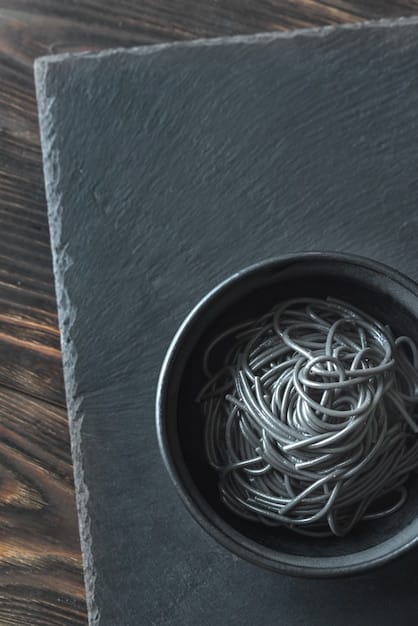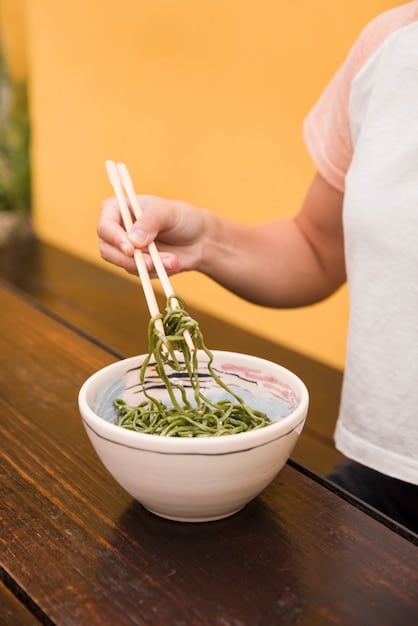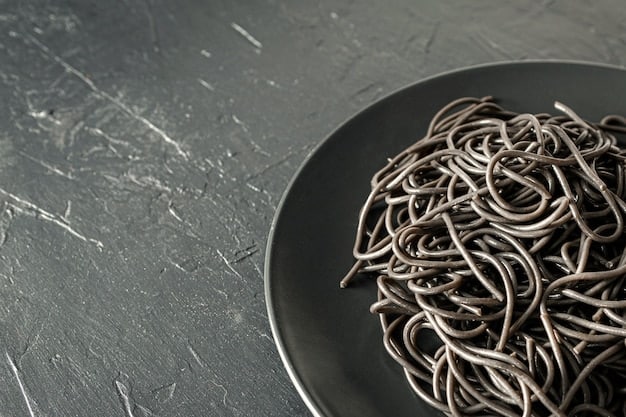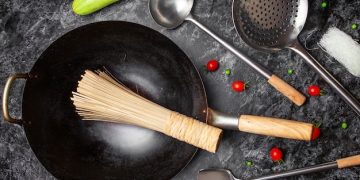The Zen of Zaru Soba: Your Guide to Cold Japanese Noodles

The Zen of Zaru Soba is a comprehensive guide that explores the history, preparation, and enjoyment of this refreshing cold Japanese noodle dish, perfect for beating the summer heat and experiencing a unique culinary tradition.
Craving a light and refreshing meal to beat the summer heat? Look no further than The Zen of Zaru Soba: A Guide to Enjoying Cold Japanese Noodles in the Summer. This traditional Japanese dish offers a delightful culinary experience that’s both simple and deeply satisfying.
Unlocking the Refreshing Mystery of Zaru Soba
Zaru Soba, a chilled noodle dish served on a bamboo tray (zaru), is a quintessential Japanese summer staple. But beyond its refreshing taste, Zaru Soba embodies a deeper appreciation for simplicity, quality ingredients, and mindful preparation.
Let’s delve into the origins, ingredients, and techniques that make Zaru Soba a truly special culinary experience.

The Origins of Zaru Soba
Zaru Soba’s history traces back to the Edo period, where buckwheat noodles (soba) were initially served hot in a broth. Over time, chefs experimented with chilling the noodles to create a refreshing dish for the warmer months. The bamboo tray (zaru) was introduced to drain excess water and prevent the noodles from becoming soggy.
Essential Ingredients for Authentic Zaru Soba
The beauty of Zaru Soba lies in its simplicity. The key ingredients are high-quality soba noodles, a flavorful dipping sauce (tsuyu), and fresh garnishes. Each component plays a vital role in the overall taste and texture of the dish.
- Soba Noodles: Choose noodles with a high buckwheat content for a nutty and earthy flavor.
- Tsuyu (Dipping Sauce): A savory blend of soy sauce, mirin, dashi (fish stock), and sugar.
- Garnishes: Common additions include chopped green onions, grated daikon radish, wasabi, and nori seaweed.
Zaru Soba is more than just a cold noodle dish; it’s a celebration of simple, high-quality ingredients that come together in perfect harmony. The choice of ingredients significantly impacts the flavor profile, emphasizing the importance of selecting the best soba noodles and crafting a well-balanced tsuyu.
Mastering the Art of Preparing Zaru Soba
Preparing Zaru Soba is a straightforward process, but attention to detail is crucial for achieving the best results. From cooking the noodles to creating the perfect dipping sauce, each step contributes to the final product.
Follow these steps to create authentic Zaru Soba at home.
Cooking the Soba Noodles to Perfection
The key to delicious Zaru Soba is properly cooked noodles. Overcooked noodles will be mushy, while undercooked noodles will be too firm. Follow these tips:
- Bring a large pot of water to a rolling boil.
- Add the soba noodles and cook according to package directions, usually around 5-7 minutes.
- Stir occasionally to prevent sticking.
- Drain the noodles immediately and rinse thoroughly under cold running water until completely cooled. This stops the cooking process and removes excess starch.

Crafting a Flavorful Tsuyu Dipping Sauce
The dipping sauce is the heart of Zaru Soba. While pre-made tsuyu is available, making your own allows you to customize the flavor to your liking. A basic tsuyu recipe includes:
- Combine soy sauce, mirin, dashi, and sugar in a saucepan.
- Bring to a simmer and cook until the sugar is dissolved.
- Let the sauce cool completely before serving.
Perfecting the art of Zaru Soba preparation involves understanding the nuances of each ingredient and technique. Properly cooked soba noodles offer the ideal texture, while a well-crafted tsuyu brings depth and complexity to the dish. The combination creates a refreshing and satisfying culinary experience.
The Zen of Presentation: Serving and Enjoying Zaru Soba
The way Zaru Soba is presented and enjoyed is just as important as the preparation. The act of dipping the noodles and savoring each bite is a mindful experience that connects you to the essence of Japanese cuisine.
Follow these tips for a truly authentic Zaru Soba experience.
The Importance of the Zaru (Bamboo Tray)
The bamboo tray is not just a serving vessel; it plays a functional role in draining excess water and preventing the noodles from becoming soggy. This ensures that each bite is perfectly textured.
Mindful Dipping Techniques
Avoid soaking the noodles in the tsuyu. Instead, dip a small amount of noodles into the sauce, allowing the flavor to coat each strand. This prevents the sauce from becoming diluted and preserves the integrity of the dish.
Savoring the Experience
Take your time to appreciate the flavors and textures of Zaru Soba. Notice the subtle nuances of the noodles, the savory depth of the tsuyu, and the refreshing crunch of the garnishes. Embrace the simplicity and find joy in the present moment.
The presentation of Zaru Soba elevates the dining experience, transforming a simple dish into a mindful ritual. From the traditional bamboo tray to the deliberate dipping technique, each element enhances the enjoyment and brings a sense of zen to the meal.
Exploring Variations and Pairings for Zaru Soba
While traditional Zaru Soba is a delight in itself, there are many variations and pairings to explore that can enhance your experience. Experiment with different ingredients and flavors to create your own unique twist on this classic dish.
Here are some suggestions to get you started:
Creative Garnishes
Beyond the standard garnishes, consider adding ingredients like:
- Thinly sliced cucumbers
- Spicy kimchi
- Grated ginger
- Toasted sesame seeds
Pairing with Complementary Dishes
Zaru Soba makes an excellent meal on its own but also pairs well with other Japanese dishes, such as:
- Tempura (lightly battered and deep-fried vegetables and seafood)
- Edamame (steamed soybeans)
- Yakitori (grilled chicken skewers)
Zaru Soba presents many opportunities for culinary exploration, inviting you to experiment with different flavors and pairings. Whether you choose traditional accompaniments or innovative twists, the goal is to enhance the dining experience and discover new ways to enjoy this versatile dish.
Finding the Best Soba Noodles and Tsuyu in the US
Sourcing high-quality ingredients is essential for creating authentic Zaru Soba at home. Fortunately, many specialty stores and online retailers in the US offer a wide selection of soba noodles and tsuyu.
Here’s where to find the best ingredients:
Asian Supermarkets
These stores typically carry a variety of soba noodles, ranging from affordable options to premium brands with high buckwheat content. They also offer pre-made tsuyu, but be sure to check the ingredients list for quality.
Online Retailers
Websites specializing in Japanese groceries offer a vast selection of soba noodles, tsuyu, and other essential ingredients. Look for brands that are imported directly from Japan for an authentic taste.
Specialty Food Stores
Some specialty food stores may carry high-end soba noodles and artisanal tsuyu. These options tend to be more expensive but offer a superior flavor and texture.
Accessing high-quality ingredients is essential for crafting an authentic Zaru Soba experience in the US. Whether you opt for local Asian supermarkets, online retailers, or specialty food stores, sourcing the right soba noodles and tsuyu can elevate your dish to new heights.
The Health Benefits of Zaru Soba
Beyond its refreshing taste, Zaru Soba offers a range of health benefits. Buckwheat noodles are a good source of fiber, protein, and essential nutrients, making this dish a nutritious and satisfying meal.
Consider these health benefits:
Rich in Nutrients
Buckwheat noodles are packed with vitamins and minerals, including magnesium, iron, and B vitamins. These nutrients are essential for maintaining overall health and well-being.
- Magnesium: Supports muscle and nerve function, blood sugar control, and blood pressure regulation.
- Iron: Crucial for red blood cell production and oxygen transport.
Low in Calories and Fat
Zaru Soba is a naturally low-calorie and low-fat dish, making it an excellent choice for those watching their weight. The simple ingredients and minimal oil content contribute to its healthy profile.
Zaru Soba presents a delicious and nutritious dining option, offering a blend of essential nutrients and health benefits. From its high fiber content to its low-calorie profile, this dish supports overall well-being and makes a perfect addition to a health-conscious diet.
| Key Highlights | Brief Description |
|---|---|
| 🍜 Soba Noodles | Buckwheat noodles, cooked and chilled. |
| 🍶 Tsuyu Sauce | Dipping sauce made from soy sauce, mirin, and dashi. |
| 🌿 Garnishes | Green onions, wasabi, nori, and daikon radish. |
| 🥢 Enjoying | Dip noodles in tsuyu and savor each bite. |
Frequently Asked Questions
▼
Zaru Soba is a cold Japanese noodle dish made from buckwheat noodles served on a bamboo tray (zaru). It is typically enjoyed in the summer months and is known for its refreshing flavor and simple preparation.
▼
Tsuyu is a dipping sauce made of soy sauce, mirin, dashi, and sugar. These ingredients create a balanced savory and slightly sweet flavor that complements the nutty taste of the soba noodles. Some recipes also include sake for added depth.
▼
While the tsuyu sauce can be made in advance, the soba noodles are best served immediately after cooking and chilling. Noodles can be stored separately, but they may lose some of their texture if kept for an extended period.
▼
Common garnishes include chopped green onions, grated daikon radish, wasabi, and nori seaweed. These garnishes add both flavor and textural contrast to the dish, enhancing the overall dining experience.
▼
Yes, Zaru Soba is indeed a healthy dish. Buckwheat soba noodles are rich in fiber and protein, while the dish is low in calories and fat. It’s a nourishing, light meal suitable for hot weather or a health-conscious diet.
Conclusion
Embracing The Zen of Zaru Soba is more than just enjoying a meal; it’s about appreciating the simplicity, flavors, and traditions of Japanese cuisine. Whether you’re a seasoned foodie or new to Japanese flavors, Zaru Soba offers a unique and refreshing culinary experience that’s sure to delight your taste buds and nourish your soul.





